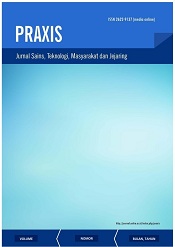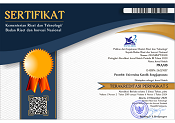Analisis Kritis Atas Kebijakan Revaluasi Aset Kementerian Keuangan Tahun 2015
Abstract
The objectives of the paper is to analyze critically the new regulation that was introduced in 22 October 2015. Indonesian government issued Regulation No. 191 / PMK.010 / 2015 aimed at getting companies to revalue their fixed asset. Under the new regulation, firms may take advantage of lower tax rate imposed on revaluation surplus.Minister of Finance believes that firm future performance will increasas the value of asset rises.The arguments go further by stating thatfirmthat has intention to offerstocks publicly for the first time would also find it beneficial. At the surface the arguments put forward by the government is quiet understandable. However, a deeper analysis shows these arguments are not based on a sound understanding of financial reporting proceduresgoverned by Indonesian Financial Accounting Statement. In summary, there are at least three fundamental weaknesses contained in the arguments: First, the government tends to forget the differences in the calculation of earnings (revenue) for tax purposes versus external reporting purposes, especially for investors and creditors. Second, equating the responsibility of private and public companies in terms of adhering to rules and standards. Third, Presuming that asset value alone determines the firms’future performance.
Keywords: Asset revaluation, operating performance, taxable income,
financial reporting.
Abstrak
Tulisan ini bertujuan untuk menganalisis secara kritis regulasi revaluasi aset yang dikeluarkan pemerintah tanggal 22 Oktober 2015. Pemerintah menerbitkan PMK No. 191/PMK.010/2015 yang diarahkan untuk mendorong perusahaan melakukan revaluasi aset. Regulasi yang baru ini menawarkan insentif pajak atas selisih nilai aset tercatat dan harga pasarnya pasca revaluasi. Menteri keuangan percaya bahwa dengan menaikkan nilai aset sesuai harga pasarnya akan meningkatkan kinerja perusahaan. Alasannya, dengan nilai aset yang tinggi, kemampuan perusahaan untuk mendapatkan kredit akan meningkat dan akan mendorong kinerja perusahaan di masa mendatang. Selain itu, perusahaan yang sedang mempertimbangkan untuk melakukan IPO akan diuntungkan karena memiliki nilai aset yang lebih tinggi. Sepintas argumen-argumen yang dikemukakan oleh pemerintah memang dapat dimengerti. Namun analisis yang lebih mendalam menunjukkan argumen-argumen itu tidak didasari pemahaman yang benar tentang prosedur pelaporan keuangan yang diatur dalam PSAK. Argumen yang dikemukakan juga cenderung menyederhanakan faktor-faktor yang mempengaruhi kinerja operasi di masa mendatang. Setidaknya ada tiga kelemaham mendasar: pertama, pemerintah cenderung melupakan perbedaan perhitungan pendapatan (laba) untuk tujuan pajak dan untuk pelaporan keuangan eksternal, khususnya ditujukan bagi investor dan kreditor. Kedua, menyamakan tanggung jawab perusahan privat dan publik dalam ketaatan terhadap peraturan. Ketiga, anggapan bahwa aset menentukan kinerja perusahaan.
Kata Kunci: revaluasi aset, kinerja operasi, laba kena pajak, pelaporan keuangan
Keywords
Full Text:
PDFReferences
Aboody, D., M.E Barth, dan R. Kaznik. 1999. Revaluations of fixed asset and future performance: Evidence from UK. Journal of accounting and economics, Vol. 26, pp 149-178.
Barth, M.E, dan G Clinch. 1998.Revalued financial, tangible and intangible assets: associations with share prices and non-market based estimates. Journal of accounting research. Vol. 36. pp. 199-233.
Beneish, M. D., dan E Press.1995. The resolution of technical default. The Accounting Review. Vol. 70. No. 2. pp. 337-353,
Bernard, V.L.1993. Discussion of an investigation of revaluations of tangible long-lived assets.Journal of accounting research.Vol. 31.pp. 39-45.
Brown, P., H.Y Izan, dan A.L Loh. 1992. Fixed asset revaluation and managerial incentives. Abacus. Vol. 28. No. 1. pp. 36-57.
Easton, P.D., P.H Eddey, dan T.S Harris.1993. An investigation of revaluation of tangible long-lived assets. Journal of accounting research. Vol. 31. pp. 1-38 (supplement).
Gaermynck, A, dan R Veugelers. 1999. Revaluation of assets as a signalling device: a theoretical and empirical analysis. Accounting and business research. Vol. 29. No. 2, pp. 123-138.
Harianterbit. Com. 2015.Jurus rajawali bangkit 1: dengan revaluasi aset ekonomi tumbuh meroket. Diakses dari http://pembaca.harianterbit.com/daripembaca/2016/01/03/52142/58/27/Serial-Jurus-Rajawali-Bangkit-1-Dengan-Revaluasi-Aset-Ekonomi-Tumbuh-Meroket
Ikatan Akuntan Indonesia.2016. IAI dukung kebijakan pemerintah terkait revaluasi.Diakses dari http://www.iaiglobal.or.id/v02/berita/detail.php?catid=&id=864
Jaggi, B, dan J Tsui. 2001. Management motivation and market Assessment: revaluation of fixed Assets. Journal of international financial management and accounting. Vol. 12. No. 2. pp. 160-187.
Kompas. Com. 2015. Insentif PPh Revaluasi Aset, Pemerintah Bisa Mendapat Tambahan Penerimaan Rp 10 Triliun. Diakses darihttp://bisniskeuangan.kompas.com/read/2015/10/23/095000126/Insentif.PPh.Revaluasi.Aset.Pemerintah.Bisa.Mendapat.Tambahan.Penerimaan.Rp.10.Triliun
Lopes, A.Bdan M. Walker. 2012. Asset revaluations, future firm performance and firm-level corporate governance arrangements: New evidence from Brazil. British accounting review.Vol. 44. No. 2. pp. 53-67
Rimanews. 2016. Menkeu minta penilai turunkan tarif jasa revaluasi. Diakses dari http://ekonomi.rimanews.com/read/20160129/258734/Menkeu-Minta-Penilai-Turunkan-Tarif-Jasa-Revaluasi-
Saudagaran, S. M. 2009. International Accounting: A user perspective. A Wolters Kluwer business. CCH.
Seng, D, and J Su. 2010. Managerial incentives behind fixed asset revaluations: evidence from New Zealand Firms. Working paper. Diakses dari http://otago.ourarchive.ac.nz/bitstream/handle/10523/1606/Seng_Fixed_Asset_Revaluations_-__submit_to_Illinoi.pdf .
Wolk, H.I., J.L Dodd, and J.J Rozycki. 2009. Accounting Theory: Conceptual Issues in a Political and Economic EnvironmentSeventh edition, Sage Publications.
Zhai, Y.H. 2007. Asset revaluation and future firm operating performance: evidence from New Zealand. Working paper. Diakses dari https://researcharchive.lincoln.ac.nz/bitstream/handle/10182/219/zhai_mcm.pdf
DOI: https://doi.org/10.24167/praxis.v1i2.1885
View My Stats | ISSN 2622-9137 (media online)







